Friday Frivolity no. 23: Janus, Roman God of Beginnings
For the New Year, looking backwards and forwards
This is an installment in the section Friday Frivolity. Every Friday, you’ll get a short essay, plus a moodboard, 3 things I’m currently in love with, words of wisdom from what I’ve been reading lately, a little shimmer of poetry, a “beauty tip,” and a question to spark thought.
—
Janus, Roman God of Beginnings

Janus, who lends his name to the month of January, is a peculiar god, and a peculiarly Roman god. He has no precedent among the Greeks. His origins are wreathed in shadow. His name derives from a root meaning “to go” or “to pass” and lends itself to the word ianua, “doorway.” The god of beginnings, endings, gates, arches, duality, choices, and transitions, his most recognizable feature is his two heads, both facing in opposite directions, one looking that way, one this way. Looking here and looking there, the faces can take in everything but themselves—and each other.
Ovid invokes two-faced Janus at the beginning of his Fasti, a six-book poem that passes through the festivals and rites of the first six months of the Roman calendar, written about half a decade after Julius Caesar reformed the old calendar of 355 days into the Julian calendar of 365 days. Janus himself appears before the terrified poet and tells him that he was once called Chaos, in an era where the four elements—air, fire, water, and earth—were mushed together into one heap. When everything was given form and order, Janus “took on the appearance and noble limbs of a god,” but his front and back stayed identical to one another—a remnant of his once chaotic state. “Whatever you see: sky, sea, clouds, earth, / All things are begun and ended by my hand,” says Janus. Next to the Horae, the Hours, he sits at Heaven’s Gates, and the king of the gods, Jupiter himself, “comes and goes at [Janus’s] discretion.”
He later gives an additional explanation for his twinsome form. Because every doorway has two sides, “[o]ne facing the crowds, and the other the Lares,” the gods of the household, Janus needs to watch both the comings and the goings. That he is bifrons, two-headed, makes him efficient, “lest [he] lose time twisting [his] neck around.” As Anne Carson says wisely in the title of her essay on sleep, “every exit is an entrance.” The keeper of exits and entrances, Janus takes on another major role: he makes sure that the door is unbarred when he chooses to send forth peace into the world, and he “hold[s] war in check” through the maintenance of “rigid barriers.”

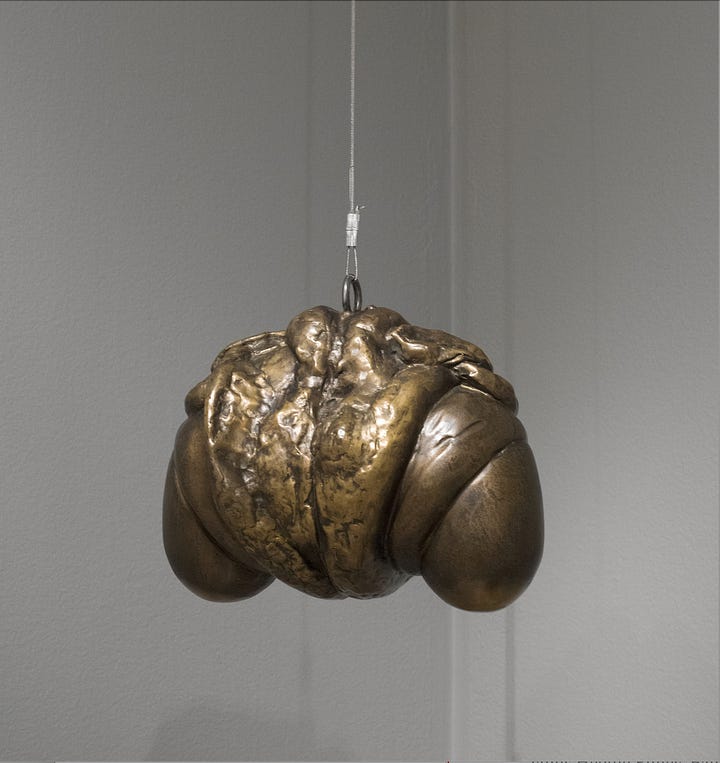
The poet then wants to know “why the new-year begins with cold, / When it would be better started in the spring?” Indeed, spring, with its new growth, new greenery, new flowers, new fresh feeling, buds and blossoms everywhere, seems to be the perfect candidate for the start of a new year. But the god replies that it is in midwinter that we see “the first of the new sun, last of the old,” as the day, having plummeted to its nadir near the end of December, begins to lengthen once more. That satisfied, the poet asks about the traditions associated with the god. Why must Janus first be given wine and incense before one prays to any other god? Because Janus, standing watch at the gods’ threshold, controls access to them. Why do people give each other good wishes on the kalends, the first of every month? Because, Janus replies, “Omens attend upon beginnings.” Why the gifts of dates and dried figs, honey and money, at the beginning of the year? So that the year might have a sweet flavor as it begins, and so that “the course of the year might be sweet as its start”—money, of course, being its own sweet.1
However, Janus, god of duality, begins to contradict himself. The poet asks him about his temple: when Rome is at war, the temple doors stand open, and when Rome is at peace, the temple doors are shut securely. The doors are open during war, Janus explains, so that the army can return to Rome, and they are closed during peacetime so that peace will not escape Rome. This seems to directly contrast with what the god had said before, that he opens the door for peace and closes the door against war. “Two-faced,” in our era, is what we call a liar. But truth, too, can have two faces. A door may be open to show that the army is not at home, that blood is being shed on distant shores, and yet Peace, too, may be abroad, trailing on the heels of War, repairing the damage and healing the wounds. A door may closed in order to keep Peace at home, and yet it may also bar the outbreak of War—Peace reigning, War restrained and in chains.

In this strange transition time between Christmas and New Year, between the year that is passing and the year that is coming, we look in two opposite directions at once, and our disparate views do not cancel each other out: they join up into a whole and complete picture. Thresholds are powerful places. I think of another mythology: the story of the Hindu Lord Narasimha. Through a boon, a demon king, Hiranyakashipu, could not be killed inside or outside, during the day or at night, on the ground or in the sky, by human or animal, or by any weapon. He wreaked his havoc with impunity, persecuting the worship of Vishnu, becoming enraged when his son expressed staunch devotion to Vishnu. So mad was he that he struck a pillar with his mace, demanding that the god appear. Vishnu did indeed appear—in the form of Narasimha (half-man, half-lion), at twilight (not day, not yet night), on the threshold (neither inside nor outside), hoisting Hiranyakashipu into his lap (neither ground nor sky) and tearing him apart with his claws (not, in the strict sense, a weapon).
I would ask you to reflect on what demons or demon kings you are facing and how, in this liminal space between waving goodbye to the old year and welcoming the new, you might find it in yourself to slay them, or at least stay them. Take strength from what you’ve been through, and find power in all you hope or imagine to achieve. The god of doorways presides over your passing, and both his faces are smiling upon you.
Mood Board of the Week for 2025
(left to right, top to bottom)
In the spirit of both looking backwards in order to look forwards, I’ve decided to take inspiration from previous Friday Frivolities to think about the mood or spirit I want to capture in the New Year.
Tippi Hedren as Marnie Edgar in Marnie (1964): On Christmas night, I rewatched Alfred Hitchcock’s Marnie (1964) with my mother, and I included it here because it reminded me of my list of 9 Unhinged Women in Film Who Shaped Me. Marnie certainly starts off as unhinged—she’s a serial thief—but becomes far more sympathetic as the story goes on. One thing my mother and I loved about her was how put-together and poised and well-dressed and elegant she was, even while committing crimes, and her careful, precise way of speaking. I love how women of that era were so neat and proper, with their gloves and hats and the way they matched their nails to their lips. However, Marnie is also highly intelligent, a spirited horsewoman, and in scenes with her co-star Sean Connery, she can give back as good as she gets. In 2025, I’d like to channel a bit of Marnie’s put-together-ness, elegance, and mysteriousness.



Tippi Hedren in Marnie (1964) One of my old websites: In this post, I included screenshots of some of the old websites I made as a teenager. As a teenager, I used to spend countless hours creating graphics, coding, designing, and, of course, writing. I basically lived on the Internet—but it wasn’t in a brainrot, social media-addicted way. For me, the Internet was a place of endless creativity, and I was always making things. I never had that much anxiety around creating—it was just play. As I got older, I became more inhibited; I worried that I could never match up to Keats or Woolf or whoever, instead of just diving in and making. Now Substack has recaptured some of that playful feeling for me, and I want to continue creating and experimenting without anxiety or inhibitions—just for its own sake, for the fun and joy of it.
Heidi Leitzke, “Arch” from Moonlit series (2015): Heidi Leitzke’s Islands (of the mind) series made an appearance in my meditation about living on the moon. I really enjoyed writing that post for the free reign that I could give to my imagination and for its sense of wonder and whimsy. Maybe 2025 is an arch I can walk through to find more wonder and whimsy—just like Leitzke’s arch here.
“HOUSE TOUR I A Pennsylvania Farm with Rolling Hills and a Historic Home” by Homeworthy: In July I wrote about my ideal house, the “Onion House.” Thinking about the idea of “home” again, I take inspiration from Ruth McKeaney’s Hillside Farm and one of my favorite house tours, the video by Homeworthy in which McKeaney not only gives a tour of her house but explains her philosophy behind home and family. The home is beautiful, of course, and its interiors are so creatively designed, but what makes it special is that everything is a reflection of the close relationships McKeaney has with the people in her life, from the herb garden planted for her by her husband to the paintings given to her by artist friends to the big barn she uses to gather friends and family and create an atmosphere of warmth and welcome.


Hillside Farm in Pennsylvania, via Homeworthy and Hungry for Home Marc Quinn, Labrador Sound Thaw (2009): In my very first Friday Frivolity, I featured one of Marc Quinn’s enormous orchid sculptures, which sparked the inspiration for the next issue, where I wrote about the strangeness and beauty of orchids and theorized the “Orchid Woman”: “She exudes exuberance; she has a shimmer on her skin; she reaches for the stars and puts them in her hair.” In this orchid painting by Quinn, I love the almost blindingly bold colors, the shock of pink and yellow and red, which perfectly captures the Orchid Woman’s boldness and vitality. Here’s to embracing our own strange beauty in 2025.
Henri Matisse, Tea (1919): The tea post is my most popular post, and I slipped this painting in right at the bottom, almost as an afterthought. Looking at it with more consideration, it exemplifies the sense of peace and quiet I want to find in the New Year—taking the time to sip tea, connect with a friend, and enjoy nature, hopefully in a garden as beautiful as this.
Diorissimo by René Gruau: Fashion illustrator René Gruau was featured in August, and here I love this drawing he made for the Dior perfume Diorissimo. I love the wide, wide smile this woman has and the way she’s literally blooming. Let’s all open ourselves up to our own flower-like flourishing in the coming year.
Charles Petillon, Point de Vue: Back in September, in a post on balloons, I wrote, “I would like to recover a sense of lightness, of buoyancy.” In this photograph by Charles Petillon, who’s done so many photographs of clusters of white balloons in strange places, I love the inclusion of the ladder. The balloons seem to represent the lofty dreams one often indulges in at the start of a new year, the ladder the steps one needs to climb in order to get there. As you can see, the steps are arduous but not unlimited—the climb may be steep, but then, think how beautiful the view!
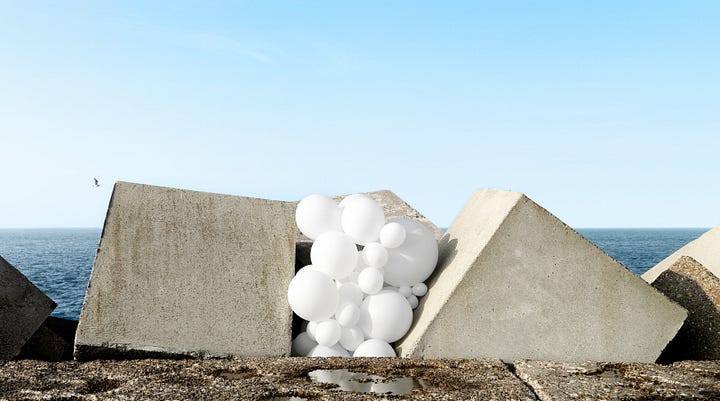

Charles Petillon, Fragilite and Cloud Computing C. Z. Guest and her son Alexander at the Villa Artemis in Palm Beach, ca. 1955, photographed by Slim Aarons: Slim Aarons made an appearance in the first Friday Frivolity, and C. Z. Guest in the one about swans. Aarons photographed socialites and celebrities as they jet-setted and swanned around, while Guest was a fashion icon who defined the simple unfussiness of American style. Born in Boston to WASP-y “Boston Brahmins,” she turned her brother’s nickname “Sissy” to the very cool, very mysterious initials “C. Z.” After boarding school, she briefly dated actor Victor Mature, was presented as a debutante, appeared in the Ziegfield Follies, went to Hollywood, and was painted nude by Diego Rivera. She married a polo player who was distantly related to Winston Churchill, and her wedding took place at Ernest Hemingway’s home, where Hemingway was best man. In her later life, she designed a collection of cashmere sweaters and, after taking an interest in horticulture, came out with a scented bug repellent. Now, none of the above is on my 2025 goals list. But I do want to embrace a spirit of adventure and have fun trying different and new things. And maybe be stylish while I’m at it.
3 Things I’m in Love With This Week I Want To Do in 2025
Romanticize my life: I used to think that this idea of romanticizing one’s life was something endemic to social media—plate your food prettily, wear a nice outfit, put an elaborate bouquet of flowers on your nightstand so you can create a fake, idealized version of your life for others to consume. But you can romanticize your life without an audience, without pressure, without optimizing for perfection, simply to bring joy and beauty into your everyday life and embrace the joy and beauty that already lie latent, waiting for somebody to notice them. I’m going to be more intentional about adding beauty to my life in small ways: wearing a ribbon in my hair just because, taking a bubble bath on a random Tuesday evening, giving my mother little violin recitals so I can really force myself to learn and memorize a piece thoroughly, bringing my film camera with me when I go to new places because I like being able to go through the physical photos later and the surprise of seeing the developed results.
Put myself out there: In 2025 I really want to not hold myself back from taking risks, interacting with more people, and doing things I’m afraid of even if it might mean failure or rejection. In particular, I want to try submitting my writing for publication—something I’ve always wanted to do but have only done very sporadically so far—and try to make more connections where I live, since most of my close friends are geographically remote.
Remember my father’s advice: Although my father is no longer physically with me, I’d like to bring something of him forward into the New Year. Some of the most valuable things I have of him are the few emails he sent me when I was about 12 or 13 and he was traveling for work. They include some very good, very loving fatherly advice. In one email, he wrote, “You should not be distracted, and you should focus on your goals, which you set yourself. With a little practice of self-discipline, you will be very successful in the future.” In another, he (very well-deservedly) lectured me on my poor sleep schedule: “It is not good to stay awake very late…. Find out a better way to do your work in a shorter time and in a better and smarter way…. Learn to eat well and sleep well…. Make some time to practice music.” I think I’m going to set myself a reminder to read his advice every morning so that I can always start my day with it and have it as my guiding light.
Words of Wisdom
Leap, and the net will appear.
—John Burroughs
I included this quotation in my very first newsletter, and it’s one that I return to now as we arrive on the threshold of a new year “fresh, with no mistakes in it yet,” as Anne Shirley says of tomorrow.2 In general, I am the kind of person who not only looks before I leap but looks instead of leaping. It’s easy to stand on the shore continually dipping a toe into the water, but it often transpires that when one simply plunges in, after the initial shock and the first bone-rattling shivers and the “Why, God why?”, one finds that one’s body adjusts quite nicely, and one is soon able to splash and play and swim and frolic very happily. When you dare to take the plunge, you find that the universe very often conspires with you. All the little helpful elves and sprites come out of the woodwork and begin to work their fairy magic when they see that you are serious about fulfilling your promises to yourself.
Poetry Corner
Sonnet IV
New yeare forth looking out of Ianus gate, Doth seem to promise hope of new delight: and bidding th’old Adieu, his passed date bids all old thoughts to die in dumpish spright. And calling forth out of sad Winters night, fresh loue, that long hath slept in cheerlesse bower: wils him awake, and soone about him dight his wanton wings and darts of deadly power. For lusty spring now in his timely howre, is ready to come forth him to receiue: and warnes the Earth with diuers colord flowre. to decke hir selfe, and her faire mantle weaue. Then you faire flowre, in whom fresh youth doth raine, prepare your selfe new loue to entertaine.
—Edmund Spenser, Amoretti
The English poet Edmund Spenser (1552-1599) is best known for The Faerie Queene, but I always loved his sonnet cycle Amoretti, which draws on his courtship of Elizabeth Boyle. As a sonneteer, he was overshadowed by Shakespeare and Sidney, his contemporaries, but I love the simpler sweetness of Amoretti. Spenser’s rhyme scheme—ABAB BCBC CDCD EE—differs from the more well-known Petrarchan and Shakespearean, creating a more complicated interweaving between lines. In that way, it embodies the idea of Janus: the middle two stanzas look backwards to their predecessors by repeating a rhyme from them, while also looking forwards by introducing a new rhyme.
In this sonnet, the speaker muses on the New Year that looks “out of Ianus gate.” It promises “hope of new delight,” and the speaker hopes that the “old thoughts” of the old year will begone in “dumpish” spirit. The New Year comes out of “sad Winters night” and projects forward into “lusty spring”; with the New Year, a “fresh love” comes out of “cheerlesse” winter, prepares, like Cupid, “his wanton wings and darts of deadly power,” and is ready to be received by the blossoming Earth, who bedecks herself for him, as the speaker imagines his beloved will do for him. These images of winter and spring may echo the May-December nature of Spenser and Boyle’s relationship: Spenser was about two decades older than Boyle. In the final couplet, the speaker exhorts the beloved directly, addressing her as “faire flowre.” Spenser’s exhortation must have worked on Boyle, because she married him, and Amoretti was published soon after their wedding in 1594. Now, we may not all have beloveds to woo in the New Year, but “new love” can take on a broader meaning, and a spirit of “new delight” is something we can all be invigorated by.
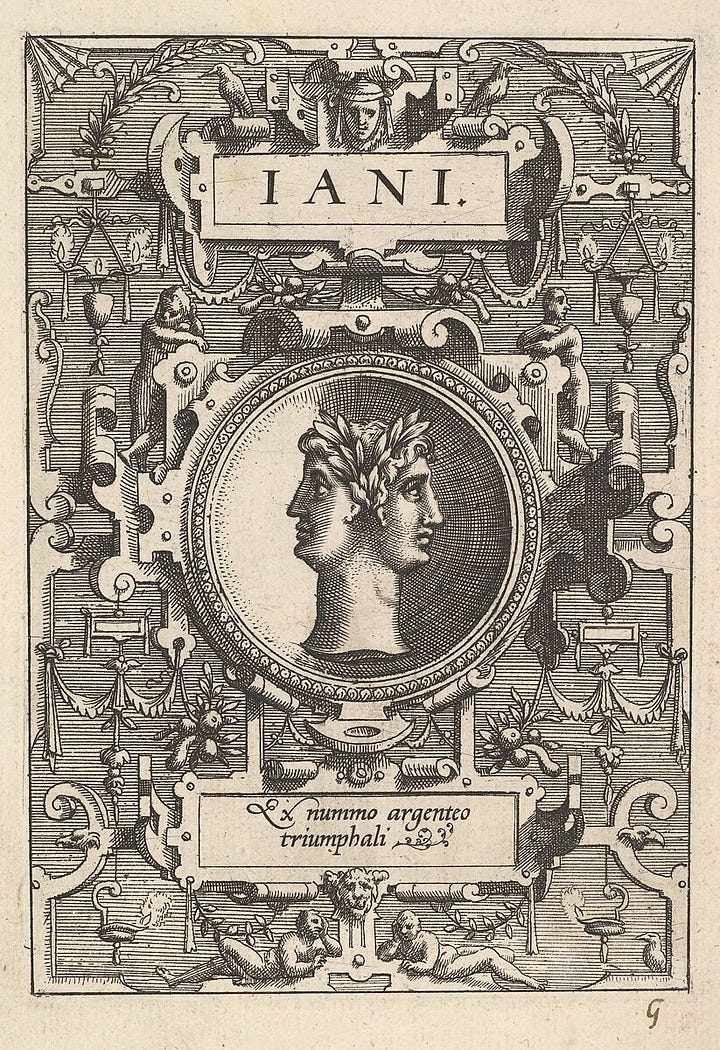
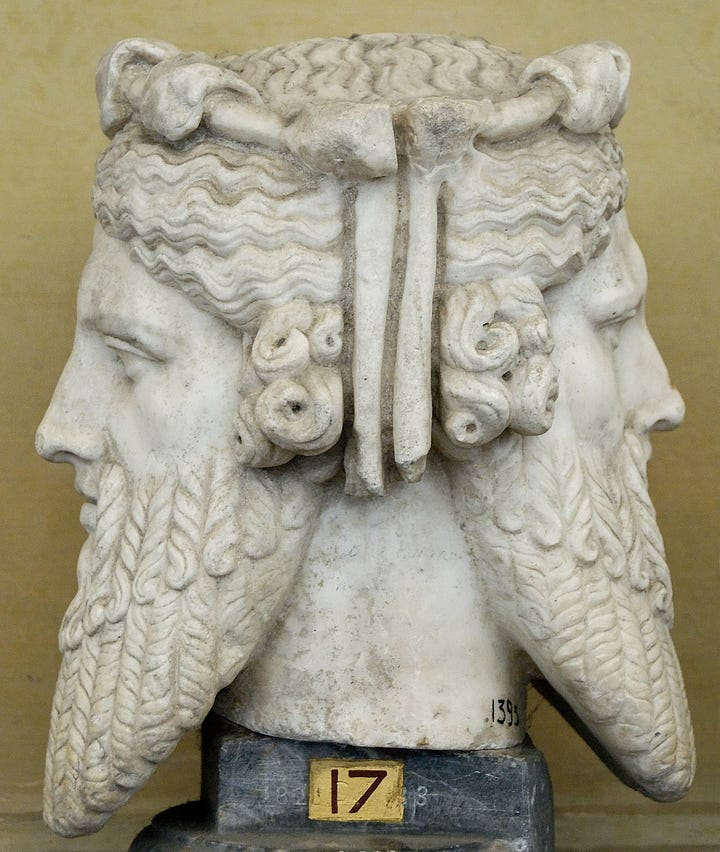
JANUS ’Tis well an old age is out, And time to begin a new.
—John Dryden, “The Secular Masque”
John Dryden (1631-1700), England’s first official Poet Laureate, was a playwright who defined the Restoration era, a literary critic whose incisiveness, range, and quality of prose made him “the father of English criticism,” and a translator whose translation of The Aeneid into heroic couplets is still unmatched for elegance and readability.
In “The Secular Masque,” he stages a miniature drama in which the god Janus, the titan Chronos, and the personification of satire Momus come together to reflect on the old age and usher in the new. Chronos, the personification of time, drops the “great globe on his back” because he can’t bear for another year “the load of human-kind.” Momus urges Janus and Chronos, “’Tis better to laugh than to cry” at the “crimes” and “bad times” of the world, and they decide to see a show of the changes that have transpired in the past age. First comes Diana, goddess of the hunt, personifying the “prime” of the age, “free from rage, and free from crime.” Next arrives Mars, god of war, causing peace and plenty to flee. Finally, it is Venus’s turn, who seems to repair the damages of Mars but whose “lovers were all untrue.” They decide that it’s a good thing the past age is finished, and as a merry chorus welcome the beginning of a new age.
Beauty Tip
As the New Year begins, add something new to your daily life—decorate your home with a new object, wear a new item of clothing, cook a new recipe, sign up for a class where you learn a new skill, switch up your usual workout or your usual breakfast or the route you take to a usual place.
Lingering Question
If you had to pick one word that you hope will define 2025 for you, what would it be?
I hope you’ve all been having a wonderful holiday season, and I hope that 2025 brings you so much joy and beauty and peace and comfort and all your heart desires. What my heart desires is a like if you enjoyed this post, and I always, always love to hear from you in the comments!
All quotations from Ovid’s Fasti are from A. S. Kline’s translation.
L. M. Montgomery, Anne of Green Gables.





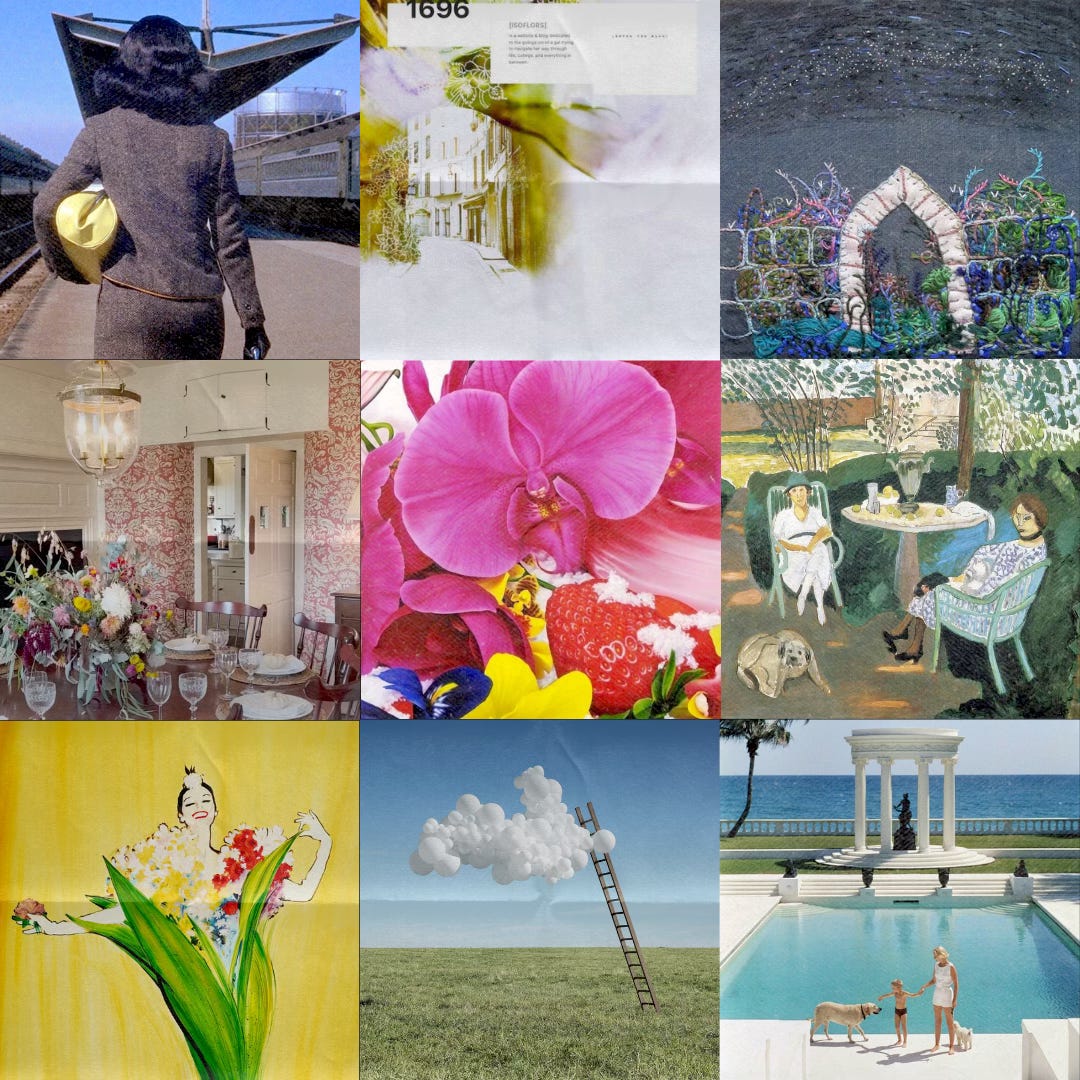
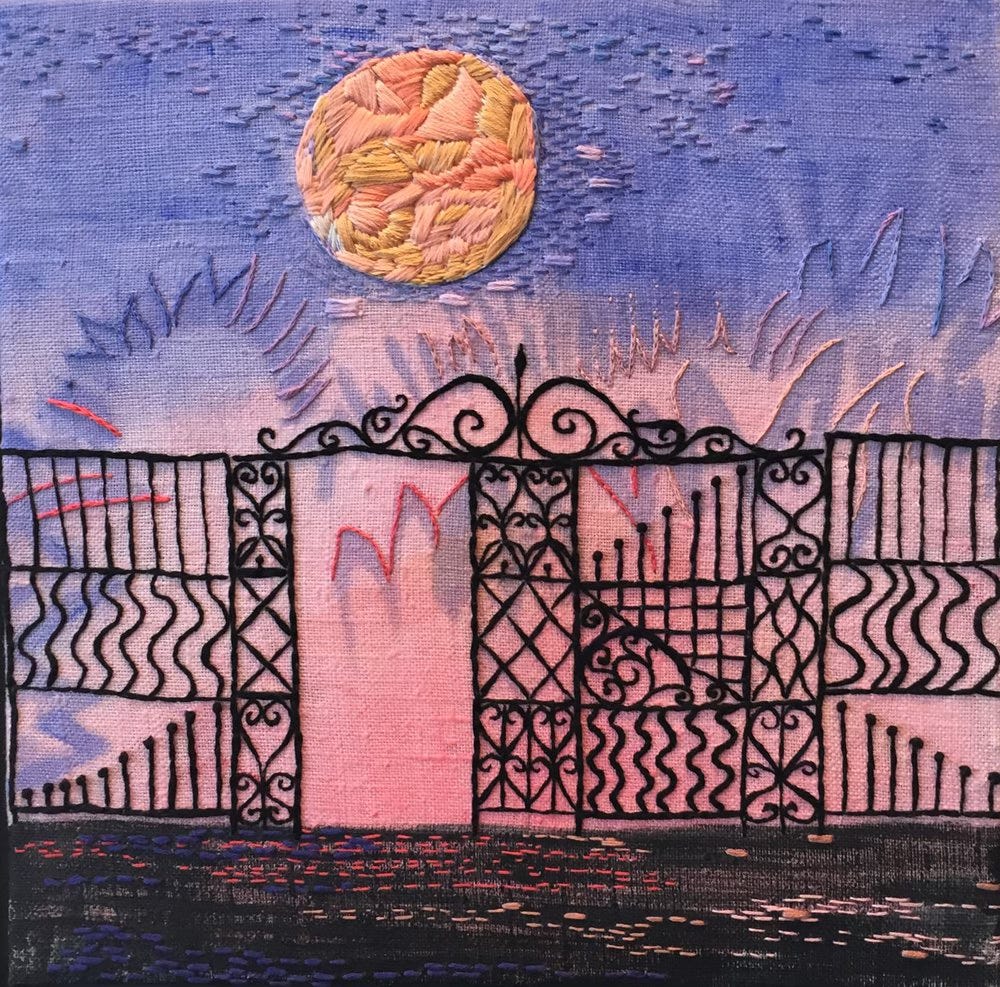




You brought all together so nicely - history, mythology, meaning of new year, words of wisdom, your own experience and reflections and much more! So beautiful and powerful. Thank you.
“simply to bring joy and beauty into your everyday life and embrace the joy and beauty that already lie latent, waiting for somebody to notice them. I’m going to be more intentional about adding beauty to my life in small ways”- so meaningful!
Wishing you the bestest of all the best this new year!
This is the best and most uplifting Friday Frivolity I’ve read (I’ve not been a subscriber for long). It filled me with hope and lightness. Thank you.